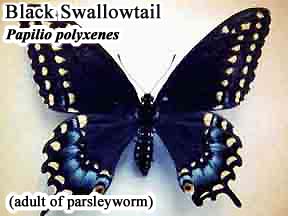Parsnip (Pastinaca)
Plant Health Problems
Diseases caused by Fungi:
Root and crown rot, Rhizoctonia solani, Pythium sp., Fusarium sp.
Symptoms appear as wilting and a slow or rapid collapse of the plant. The roots can appear brown and water-soaked instead of white. A water-soaked lesion can often appear at the base of the stem.
Control can be achieved by using a two-year rotation with nonsusceptible plants, such as corn, to prevent the buildup of pathogenic organisms.
Sore head, Itersonilia sp.
The disease is caused by a fungus and causes damage on the roots, crown, and leaves. The diseased parsnip roots show dark, irregular, slightly sunken pits. These cankers are usually limited to the "shoulders" of the parsnip, but may extend toward the tip of the root in cases of severe infection. The fungus can also infect the leaf and cause a minute spot which can enlarge to form an irregularly-shaped lesion. The spores of the fungus wash down and infect the roots, where the cankers are produced.
Good drainage and rotations with other crops for periods of six years can provide some control. The cultivar Model is partially resistant. It has been reported that treating the foliage with copper fungicides will partially protect the foliage. This will in turn reduce the number of infected roots. Consult the label for dosage rates and safety precautions.
Leaf spots, Alternaria sp., Cercospora sp.
Leaf spots are caused by fungi and appear as small angular spots with yellowish-green to dark brown spots on the foliage. These spot can coalesce and cause the leaf to drop off.
Control can also be achieved with the use of fungicide sprays applied as soon as symptoms are visible. Among the compounds registered for use in Connecticut are iprodione and chlorothalonil. Consult the label for dosage rates and safety precautions.
Powdery mildew, Erysiphe sp.
The disease is caused by a fungus and appears as white powdery patches on the upper and lower surface of the leaves. These patches eventually coalesce and can cause leaf browning.
The disease is not usually seen in Connecticut and controls are usually not needed.
Diseases caused by Bacteria:
Parsnip blight, Pseudomonas marginalis.
This disease is caused by a soilborne bacterium and causes a browning of the root interior.
Control can be achieved by practicing two-year rotations out of parsnips.
Diseases caused by Phytoplasmas:
Aster yellows, phytoplasma.
Parsnips that have aster yellows have an abnormal number of leaves. The leaves are yellow, twisted, and stunted. The roots remain slender and have an abnormal number of fine hairy roots. Parsnip yellows is caused by a phytoplasma which also causes lettuce yellows, carrot yellows, and aster yellows. Phytoplasmas are carried by leaf hoppers.
To keep down the amount of disease, growers should control leaf hoppers with insecticides and avoid planting carrots near asters.
Diseases caused by Nematodes:
Root-knot nematodes, Meloidogyne hapla.
Infected plants are stunted and sickly, with knots on their small, feeding roots. This disease is caused by nematodes which can persist in the soil for years.
Rotation with nonsusceptible plants, such as corn, can reduce the number of nematodes in the soil. Growing parsnips in a new area will also control the disease. Care should be taken to avoid carrying any soil from the old site to the new site.
Insect Problems:
Aphids.
The bean aphid, green peach aphid and the potato aphid all occasionally infest parsnip. See Aphid fact sheet
Carrot rust fly, Psila rosae.
This insect injures the roots of parsnip. This slender fly, 1/4 inch in length, with a metallic blue-black body emerges from overwintering as a pupa in mid-May. It lays eggs in the soil close to the plant late in May, and the young maggots work their way downward along the root and begin feeding at the tip of the root. Older larvae tunnel in the lower third of the main root. The burrows are rusty brown in color, which explains the name. The maggots pupate in the soil and there are two generations of the fly each season. The first generation maggots feed from June to July and the second generation from late August into September.
This insect has not been a serious pest in Connecticut and control has not been necessary. It has been a pest on muckland areas in New York State where carrots and celery are grown.
 Parsleyworm or Black swallowtail, Papilio polyxenes.
Parsleyworm or Black swallowtail, Papilio polyxenes.
This colorful caterpillar is occasionally found on carrot, parsley, dill, fennel, celery, and other cultivated or wild members of the carrot family. The caterpillars are about 2" long when fully grown, and green with a yellow-spotted black crossband on each segment. The adult is the common large black swallowtail butterfly with a wingspread of almost 4". It has two nearly parallel rows of yellow spots on the outer margins of the wings and other light blue areas on the rear wings. This insect overwinters as a tan chrysalis and there are two generations each year. They rarely require control other than hand picking.
Parsnip leafminer, Acidia fratria.
Parsnip leaves are sometimes mined by the larvae of this insect in May, June, and July.
The larvae are greenish, about 1/4" long when full grown, and they form blotch mines that are most abundant on the lower leaves. The insects pupate within the mines and later emerge as a pale yellow fly with green abdomen and brown curved bands on the wings. Control is not generally needed.
Parsnip webworm, Depressaria pastinacella.
When parsnip and celery are grown for seed, some injury may be caused by this caterpillar which webs together and feeds upon the unfolding blossom heads. The caterpillar is slightly more than half an inch long when full grown, greenish yellow with black head and legs, and covered with small black warts. There is one generation a year and the moths live through the winter. When nearly mature, the caterpillars leave the web and burrow inside the flower stems where they pupate. Control is not usually necessary.

